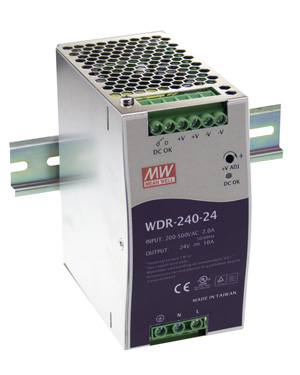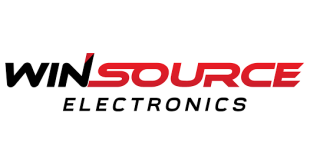 DIN rail implementations are increasingly popular for industrial control, instrumentation and automation applications because of their extensive standardisation and easy assembly. All types of industrial components, including an increasing range of AC-DC power supplies, can be simply snapped onto a DIN rail to build any desired configuration.
DIN rail implementations are increasingly popular for industrial control, instrumentation and automation applications because of their extensive standardisation and easy assembly. All types of industrial components, including an increasing range of AC-DC power supplies, can be simply snapped onto a DIN rail to build any desired configuration.
While any power supply must be correctly specified to succeed in its application, choosing the right supplier is equally as important. This is to ensure that all units delivered over the lifetime of the project meet their stated specifications while performing reliably and safely in the field. Accordingly this article reviews the sourcing considerations as well the technical factors to weigh up when choosing a DIN rail power supply for your next project.
Technical aspects
Mechanical and thermal as well as electrical considerations are important. Although different DIN rail types exist, most supplies mount on 7.5mm or 15mm depth Top Hat types, with heights of 75mm, 35mm (standard) and 15mm (miniature). To minimise final system size, Thin Width profiles down to 32mm are available.

Because DIN rail systems must operate for extended periods while being densely packed with heat-generating components, PSUs that run cool without fans or forced-air cooling are essential. High-efficiency supplies with low no-load power consumption should be specified, ideally with built-in PFC. Prolonged over-temperature operation will shorten the PSU’s life even without immediate failure, especially if any internal electrolytic capacitors are overheated.
DIN PSUs should be electrically protected from short circuit, overload, over-temperature and over-voltage conditions, caused by either the incoming mains or its load. Providing a choice for automatic or manual reset after a fault is cleared is also important. Additional features such as a DC UPS function or extra control signal contacts are highly desirable for many applications.
If the DIN rail system is intended for the UK, Europe or North America, then a PSU with a universal AC input range of 80 – 264 Vac and frequency range of 47-63 Hz is required. If use in the US for controlling electric motors is intended, compliance with UL 508 is essential. Interference with system clock frequencies can be avoided by using fixed switching frequencies of, say, 100 KHz.
 Supplier considerations
Supplier considerations
For low-volume products, settling for a power supply that approximately matches a project’s specifications may be the best route as customisation costs cannot be justified. This changes, however, once production volumes reach levels where energy or space savings, or improved reliability, start to yield a worthwhile return on modification of standard units or even full customisation.
The in-depth understanding required, together with the necessity of close control over design, manufacturing, testing and compliance procedures, calls for dealing directly with the PSU manufacturer rather than a third-party distributor. This does not have to mean working with a remote factory in a different time zone though. The best of both worlds is offered by manufacturers such as Sunpower, which combine the advantages of overseas manufacturing with a well-staffed, well-resourced local presence.
 A local office like this can support customers from initial sales and design through manufacturing and even beyond; for example, staff can streamline RMA procedures by performing preliminary analysis in the UK.
A local office like this can support customers from initial sales and design through manufacturing and even beyond; for example, staff can streamline RMA procedures by performing preliminary analysis in the UK.
When initial concepts are being discussed, sales engineers can draw on in-house understanding and data related to a power supply’s operation, the manufacturing procedures involved, and any relevant safety legislation. This ensures that all relevant angles are covered, including some that perhaps the customer had not originally considered. In spite of this flexibility, it is important to use standard parts wherever possible to minimise costs and lead times.
As the project moves from concept to design and then manufacturing, close co-operation between the customer, the sales engineers and the production engineers in the factory can be managed through in-house control of all technical documentation, versions and revisions for specifications, drawings and circuit diagrams. Engineering Validation Tests (EVTs) with Design Verification Tests (DVTs) can be used on prototypes to ensure they meet the customer’s specifications and design goals. Design problems can be identified early, and corrected while their impact is minimal. Testing can cover all areas of concern to an OEM, including function, performance, environmental, mechanical, reliability, EMC and safety requirements. Conformance testing can also be performed if specified.
The complete, end-to-end process – sales, design and manufacturing and support – will also benefit from ISO 9001 accreditation. The disciplined environment allows the PSU manufacturer to work more efficiently; through saving time and cost by reducing mistakes, this raises customer service to a consistently improved level. From the OEM customer’s perspective, the externally audited, internationally-recognised quality management system eliminates their need to carry out their own costly and time-consuming quality audit.
Sunpower UK offers a wide range of UL 508-compliant DIN rail power supplies for industrial, process control and automation applications. For more information visit www.sunpower-uk.com
Sunpower Technology LLP
Tel: 0845 5330438
 CIE Components in Electronics
CIE Components in Electronics

